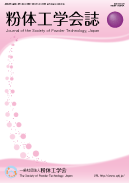
- |<
- <
- 1
- >
- >|
-
 Development of the Simulation for Deformation Behavior of Metal Particles by Distinct Element MethodKosuke Ono, Kizuku Kushimoto, Shingo Ishihara, Junya KanoArticle type: Original Paper
Development of the Simulation for Deformation Behavior of Metal Particles by Distinct Element MethodKosuke Ono, Kizuku Kushimoto, Shingo Ishihara, Junya KanoArticle type: Original Paper
2019Volume 56Issue 2 Pages 58-65
Published: February 10, 2019
Released on J-STAGE: March 16, 2019
JOURNAL FREE ACCESSA new simulation model to deal with metal powders was developed. The feature of the proposed model is to express plastic deformation behavior of metal powders. The model is based on Advanced Distinct Element Method (ADEM), which can represent deformation behaviors of elastic materials. The change of the proposed model from ADEM is interaction force of primary particles. In order to confirm the validity of the new model, compression tests and drop tests have been carried out in experiment and simulation. In compression tests, test tablets were thinly stretched and the deformation was maintained. In drop tests, a dimple was formed on the tablet when an iron ball collides. Characteristic behaviors of metal material such as stretching the tablets and forming a dimple were also confirmed in simulation. Therefore, it is identified that the proposed model could express the behavior of metal material.
View full abstractDownload PDF (3502K) -
Tetsuya Yamamoto, Hideto YoshidaArticle type: Original Paper
2019Volume 56Issue 2 Pages 66-73
Published: February 10, 2019
Released on J-STAGE: March 16, 2019
JOURNAL FREE ACCESSTangent line method and Twomey’s non-linear iteration method are applied to retrieve a particle size distribution from the sedimentation curve measured with a sedimentation distance in sedimentation tube. It is found that it is difficult to calculate the particle size distribution by the tangent line method using the sedimentation curve drawn from visual observation of the interface. On the other hand, the particle size distribution can be predicted numerically by Twomey method although the reliability is low. In order to improve the measurement accuracy, improved method to define the sedimentation interface using image analysis is investigated. Furthermore, introduction of correction term to Twomey method improves the reliability of the particle size distribution. As a results, this calculation method can be applied to measure particle size distribution not only for glass beads but also suspension concentrate of agricultural fungicide penthiopyrad.
View full abstractDownload PDF (1066K) -
Takahiro Ohmura, Taichi Tasaka, Kento Ishii, Taiga Tsuji, Mizuho Minam ...Article type: Original Paper
2019Volume 56Issue 2 Pages 74-80
Published: February 10, 2019
Released on J-STAGE: March 16, 2019
JOURNAL FREE ACCESSRecently, the practical use of high performance insulation materials such as nanoparticles insulation material or the vacuum insulation material has been spreading to various kinds of industrial fields including industrial furnaces, buildings, home electric appliances, thermal or cold insulation boxes. However, it is very difficult to measure the thermal conductivity. Because uniform temperature gradient for applying Fourier’s low must be achieved in the test specimen. To solve this issue, we have proposed a new method to measure the thermal conductivity of specimens which includes ununiformed temperature gradient areas, and have developed an apparatus with simple structure. In this paper, we have applied this method for the measurement until 400°C. As the result, the thermal conductivity of the ceramics fiber insulation, the calcium silicate, and the nanoparticle material insulations agreed within ±10% for the previous studies in the temperature range from 100°C to 400°C. The uncertainty of the measured values also made clear this method is reliable.
View full abstractDownload PDF (618K)
-
Toshitsugu TanakaArticle type: Fundamentals of Powder Technology, 2nd Edition
2019Volume 56Issue 2 Pages 81
Published: February 10, 2019
Released on J-STAGE: March 16, 2019
JOURNAL RESTRICTED ACCESSDownload PDF (225K) -
Toshitsugu Tanaka, Takuya TsujiArticle type: Fundamentals of Powder Technology, 2nd Edition
2019Volume 56Issue 2 Pages 82-86
Published: February 10, 2019
Released on J-STAGE: March 16, 2019
JOURNAL RESTRICTED ACCESSDownload PDF (631K)
- |<
- <
- 1
- >
- >|